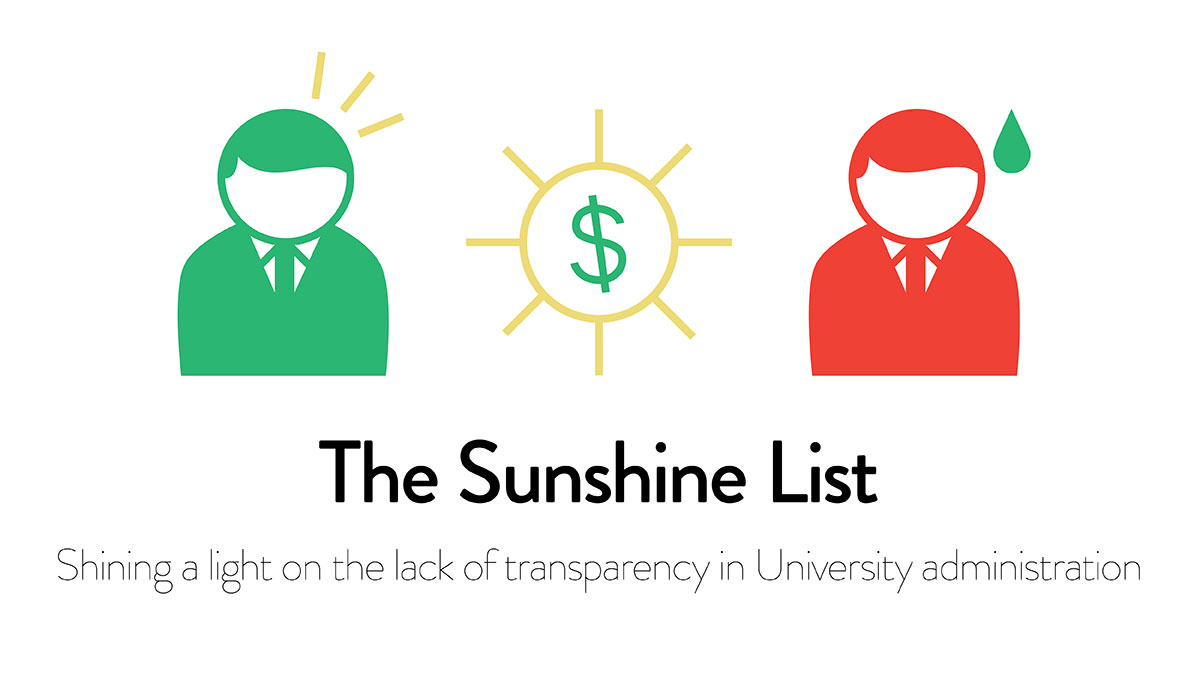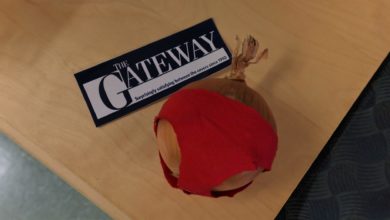Feature: The Sunshine List
 Alex Patterson
Alex PattersonIan Marshall* is a tenured professor in a professional faculty. In addition to his $190,000 salary, he receives an off-the-record “faculty allowance” of $5,000 each year. Though the official purpose of this stipend is to purchase books and cover conference expenses, Marshall used his allowance last year to purchase two iPads for personal use, cell phones for his kids, and a vacation to Maui over spring break.
According to the University of Alberta’s Human Resource Services’ 2015 base salary scales, Marshall earns $46,000 more than what a full-time professor ought to receive in compensation. Including his faculty allowance, his salary is four times as much as the average Canadian. Still, if he had to guess, his salary is among the lowest in his department.
“But, honestly, I have no idea what anyone else is making,” Marshall said. “I don’t know if I’m being paid fairly compared to my colleagues, but I know I’m being paid far more than the people in arts or sciences.
“There are good reasons for differences in salary, but it’s hard for the university to justify a discrepancy like that, so they don’t try.”
***
In June, the University of Alberta will release a “sunshine list” of all staff whose salary exceeds $125,000. Because of the expansion of the 2013 Compensation Transparency Act, all post-secondary institutions, health service providers, and Government of Alberta employers must release the names and salaries of employees who earn more than the provincial compensation threshold, unless this disclosure “threatens their safety.”
According to the Ministry of Justice, the act is meant to “increase transparency” by revealing how tax dollars are spent. In 2015, 56 per cent of the U of A’s expenses — about $983.2 million — were spent on “learning,” which staff salaries fall under. This information is available through the Office of the Vice-President (Finance and Administration)’s website, which only publishes how many millions the university spends on general issues such as “learning,” “ancillary services” and
“special purposes.”
The U of A — which the Office of Advancement claims is the province’s fourth largest employer — receives just 17 per cent of its revenue from student tuition. The university’s primary stakeholders, then, are taxpayers, who, in 2015, invested $897 million of government grants in the institution. Because the U of A is the beneficiary of such a substantial amount of public funding, transparency, from a taxpayer perspective, is a must.
***
Thomas Cohn,* a professor within the Faculty of Arts, received his PhD from the same Oxbridge college as Marshall and has been teaching at the U of A for the same length of time. His salary is $125,000 a year — about $65,000 less than Marshall’s. He doesn’t know what a faculty allowance is.
But for Cohn, the sunshine list will reveal more than just which fields boast the highest salaries — which, for anyone who has walked the seven-minute trek from FAB to the upper floors of Tory, comes as no surprise.
“There’s a lot of secrecy right now about how much individuals or even certain categories of people earn, and that, I suspect, leads to systemic forms of injustice,” he said. “One of the interesting conversations that will emerge is that we will very likely notice some gendered patterns there, some patterns of race or indigeneity, and that will be interesting information to have out there.”
Professors, associate professors, and assistant professors earn a uniform base salary according to a scale, which is published by Human Resource Services. What is not published, however, is the collective bargaining and negotiations many new hires partake in, which can add tens of thousands of dollars to their salary permanently. And as long as hiring committees are made up of senior faculty members — who, because of historical injustices, tend to be white men — collective bargaining can often involve a gendered or racial dynamic.
When the University of British Columbia published a sunshine list in accordance with provincial laws in 2007, observers from the student newspaper, The Ubyssey, noticed a disturbing trend that female professors were, on average, paid $3,000 less than their male counterparts. As a result, the UBC Equity Office conducted studies over the course of three years, which resulted in tenured female faculty receiving a two per cent pay raise in 2010. Before the list was released, pay inequity had not been looked into by administration since the 1980s.
“It’s not just that we might discover that professors in economics earn more than professors in philosophy,” Cohn said. “We might actually see that there are these really big differences in salary (between groups of people) that are a little bit hard to explain or justify.”
It’s possible the sunshine list will reveal pay equity problems at the U of A. Human Resource Services’ employment equity plan is 22 years old, and has not been revised since 1998. If the sunshine list reveals significant wage gaps between male and female or white and ethnic minority university staff — as it did at, not only UBC, but the University of Toronto, the University of Western Ontario, and Dalhousie University — administration may feel pressure to take a more serious stance on equity issues.
But according to Wayne Patterson, the executive director of Human Resource Services, the university is simply complying with a legal act — there is no intention to look into the kind of information the list may reveal.
“It won’t be serving that purpose at all,” Patterson said. “We can’t control any sort of observations of conclusions people may draw from it.”
“The university would have to look at pay equity or anything like that through separate measures. It wouldn’t be as a result of compensation disclosure.”
***
Despite the benefits of releasing a sunshine list, Marshall and Cohn, like most professors at the U of A, “fundamentally disagree” with the use of sunshine lists on university campuses. Their privacy is so dear to them that they chose to remain anonymous in this article, even though their names and salaries will be made public in June.
“Honestly, I think the salary of professors … is pretty low down on my list of what I as a taxpayer want to know to make good judgments about how my government is serving me,” Cohn said.
According to Cohn, there isn’t a strong public understanding of what it takes to become a professor. The list will only publish names and salaries, and will not include how many degrees the person has, how long they have been teaching, or whether they are a foremost thinker in their field. When spread over a lifetime, the salaries disclosed in the sunshine list “might not be as a rosy as they seem.”
For Ricardo Acuna, the Executive Director of the Parkland Institute, the transparency provided by sunshine lists is incidental. In his eyes, their primary purpose is to help right-wing governments — like that of Alison Redford, who first passed the Compensation Transparency Act in 2013 — push for the privatization of public services.
“(These lists) come from an argument that has been made from the political right for years, a position that government is ineffective and inefficient and wasteful,” Acuna said. “What publishing individual names does is open up a space for public shaming and public bullying.”
“There are better ways to deal with equity problems … and that’s the internal work of the university. That’s not for the public-at-large to get involved in what a university professor should make and what a university professor should not make.”
Though Acuna said he believes the problems with transparency on campus are “overstated,” the mystery behind where our tax and tuition dollars go is unsettling. Administration has been far from transparent in detailing the amount of money certain professors make after collective bargaining and negotiations. This creates a culture of uncertainty. If someone’s salary is $46,000 more than what official U of A documents claim to pay them, it’s easy to wonder how many other people on campus are beneficiaries of a system that is dishonest to students and taxpayers.
The publication of individuals’ salaries is undoubtedly an invasion of privacy. When you go to the bank, the teller doesn’t announce your account balance over an intercom. But, given the chronic lack of transparency on almost every level of governance at the U of A, the publication of a sunshine list is a necessary evil.
***
The U of A prides itself in taking strides towards social justice, whether it’s through the kinds of courses they offer or the events they support (or suppress) on campus. Such outward-facing initiatives are easier for administration to partake in than looking critically at the issues facing our university internally.
The Office of the Vice President (Internal Commun-
ications) and Change@UAlberta, the two administrative vehicles committed to creating a “culture change” in “transparency and communication” and “accountability at every level,” declined to comment on this article. Transparency is often thrown around as buzzword by high-level administrators, but it is clear there is little commitment to making the university’s financials more visible to the public. The people who benefit most from a system are the least likely to change it.
The sunshine list will provide U of A staff with annual juicy reading and give students ammunition against their teachers as they formulate cutting Rate My Professor reviews at the end of each semester. But, above all, the list may provide a much-needed push for administration to reform its culture of secrecy into one of transparency and equity. Because the university seems uninterested in reforming its own flawed institutions, it is up to students and staff to provide
an incentive.
*Names have been changed to assure anonymity.





The fastest growing portion of the ‘human resources’ budget at U of A, as well as most other post-secondary institutions in North America is for ‘administration’. Just as in the correspondingly large private sector corporations, the number of those ‘at the top’ has expanded exponentially along with their compensation. And then they have to have large numbers of boot-lickers and other staff to support their expanded job descriptions and egos. At least the tea
chers work for a living and do something that affects the lives of their students positively.
I wonder why students need “ammunition against their teachers”? Since when were professors the enemy of students? It is this sense of mindless bias that renders things like USRIs (IDQs) and Rate-My-Prof meaningless as real measures of effectiveness in student learning.
And as a point of information, there is no such thing as a $5000 Faculty Allowance at the U of A (so no surprise that “Professor Cohn” has never heard of it). However, every faculty member may claim annually up to $1400 as a Professional Expense Reimbursement:
https://www.hrs.ualberta.ca/Benefits/Funding/PER.aspx